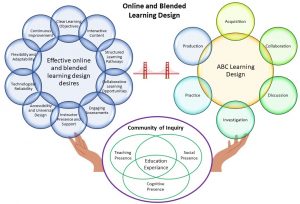
In collaborating with my PBL group to design an introductory online blended course using the ABC learning method, I gained valuable insights into the process of course design and the effective integration of different teaching approaches. Through our discussions and brainstorming sessions, I learned the importance of aligning the learning activities and assessment criteria with the intended learning outcomes. Additionally, our group’s exploration of various tools and technologies allowed us to select those that best supported the specific learning activities in each module. This experience reinforced the significance of thoughtful selection and integration of digital tools to enhance the teaching and learning experience. The webinar with Dr. Robin Kay was also informative, where I learned about the community of inquiry model and assessment techniques. According to this model, well-balanced and effectively integrated cognitive presence, social presence, and teaching presence are crucial for deep and meaningful learning outcomes.
Blended learning has experienced notable expansion as a teaching approach, and research consistently indicates its positive impact on learning outcomes (Namyssova, et al., 2019). It is evident that the design and implementation of blended course structures and pedagogical choices play a crucial role in achieving these favorable outcomes. Designing for online and blended learning involves creating engaging and effective learning experiences that take advantage of the unique opportunities and challenges presented by digital platforms (Graham et al., 2013). Some of the key considerations and design principles to keep in mind are illustrated in the figure above. It involves incorporating interactive multimedia, fostering communication and collaboration, implementing formative assessments, ensuring accessibility and usability, and embracing continuous improvement through learner feedback.
Reflecting on my current practice as a course responsible for two online postgraduate courses, I realize the importance of continuously improving my teaching knowledge and exploring current practices in learning design. This ONL course has provided me with valuable insights into creating engaging blended and online learning experiences for learners. As I delve into Topic 4, which focuses on the perspective of the educator in the design for learning, I am eager to incorporate more effective principles, approaches, and tools discussed to enhance student engagement, active learning, collaboration, inclusivity, and sustainability.
One of the key aspects emphasized in this topic is the need to enhance community-building and promote student engagement and ownership in learning. According to the literature, students are more likely to thrive in a blended and online learning environment when they feel connected to a community of learners. To achieve this, I need to design learning experiences that foster active participation and collaboration. Approaches like active learning, PBL, collaborative learning, and networked learning are recommended as effective strategies to engage students and facilitate deeper learning. Some means to incorporate these learning approaches in my courses could be through: 1) Designing interactive activities that encourage active participation, such as online discussions, group projects, and case studies; 2) Implementing PBL by presenting real-world problems for students to solve, fostering critical thinking and problem-solving skills; 3) Facilitating collaborative learning through group assignments, peer feedback, and online teamwork platforms; and 4) Leveraging networked learning by utilizing collaborative tools to connect students with each other and with teachers.
In conclusion, this reflection on my experience as a learner in the ONL course and my engagement in Topic 4 has highlighted the significance of designing for student engagement, active learning, collaboration, inclusivity, and sustainability. I would like to explore how to implement the principles and approaches discussed and AI tools (including ChatGPT) in my teaching practice to create more engaging and effective online courses. By continuously reflecting on and refining my teaching strategies, I aim to provide my students with a collaborative and enriching learning environment that promotes deep understanding and skills development.
References
- ABC Learning Design –homepage and resources
- Graham, C. R., Woodfield, W., & Harrison, J. B. (2013). A framework for institutional adoption and implementation of blended learning in higher education. The internet and higher education, 18, 4-14.
- Namyssova, G., Tussupbekova, G., Helmer, J., Malone, K., Mir, A., & Jonbekova, D. (2019). Challenges and benefits of blended learning in higher education.